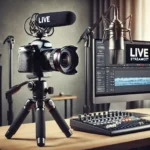Introduction
Live streaming has become an essential tool for content creators, businesses, and educators. However, technical issues can disrupt your broadcast, leading to frustration and audience drop-off. Effective troubleshooting and best practices can help you maintain a smooth and high-quality stream. This guide will walk you through common live streaming issues and how to fix them efficiently.
Common Live Streaming Issues
Before diving into solutions, it’s important to understand the common problems that can arise during a live stream. These include:
- Buffering and Lag: Streams frequently pause or are delayed.
- Low Video Quality: Blurry or pixelated video output.
- Audio Sync Issues: Audio is out of sync with video.
- Connection Drops: Unstable or lost internet connection.
- Stream Latency: Significant delay between real-time action and stream.
- Encoding Errors: Software or hardware encoding issues.
Identifying the root cause is the first step toward troubleshooting effectively.
Best Practices for Troubleshooting Live Streaming Issues
Optimize Your Internet Connection
A stable internet connection is crucial for a smooth live stream. Follow these steps to ensure optimal performance:
- Use a Wired Connection: Ethernet is more reliable than Wi-Fi.
- Check Your Upload Speed: Ensure you have at least 5 Mbps for HD streaming and 10+ Mbps for Full HD or 4K.
- Reduce Bandwidth Usage: Limit connected devices or pause downloads while streaming.
- Enable Quality of Service (QoS): Prioritize streaming traffic on your router.
Adjust Streaming Software Settings
Incorrect software configurations can lead to buffering and poor video quality. Optimize settings with these adjustments:
- Lower Bitrate: Reduce bitrate if experiencing lag or buffering.
- Choose the Right Encoder: Use hardware encoding (NVENC, QuickSync) for efficiency.
- Set Frame Rate and Resolution Correctly: Avoid overloading the system with overly high settings.
- Update Your Streaming Software: Stay updated with the latest version of OBS, Streamlabs, or other software.
Improve Hardware Performance
Your computer and streaming equipment can impact stream quality. Take these steps:
- Upgrade Your CPU and GPU: Higher-quality streams require strong processing power.
- Increase RAM: Ensure at least 8GB RAM, but 16GB+ is preferred.
- Use an External Capture Card: Reduces CPU load for console or dual-PC streaming setups.
- Proper Ventilation: Prevent overheating by maintaining good airflow and cooling solutions.
Resolve Audio and Video Sync Issues
If your audio is out of sync with the video, apply these solutions:
- Adjust Audio Delay: Use the streaming software’s built-in sync options.
- Check Capture Card Latency: Some cards introduce input lag; fine-tune settings.
- Use Low-Latency Audio Interfaces: Better audio equipment reduces delay issues.
- Test Before Going Live: Run test streams to check sync issues beforehand.
Minimize Latency and Connection Drops
Stream interruptions can be frustrating, but you can minimize them with these methods:
- Choose Low-Latency Streaming Mode: Platforms like YouTube and Twitch offer lower latency settings.
- Use a Secondary Internet Connection: Hotspot or backup connections help prevent downtime.
- Close Unnecessary Background Applications: Reduce network congestion and CPU usage.
- Monitor Stream Health Metrics: Platforms provide real-time metrics to diagnose issues.
Avoid Encoding Errors
Encoding problems can cause crashes or degraded stream quality. Regular maintenance can help prevent this:
- Monitor CPU Usage: High CPU load causes encoding overload.
- Reinstall or Update Encoding Software: Keeping OBS Studio, Streamlabs, or other tools up to date prevents errors.
- Choose Hardware Encoding When Possible: Offloads workload from CPU to GPU.
- Use Recommended Bitrate Settings: Refer to platform-specific guidelines.
Benefits of Troubleshooting and Applying Best Practices
Solving live streaming issues ensures a better experience for both you and your audience. Key benefits include:
- Improved Stream Quality: Clear visuals, synced audio, and smooth playback.
- Increased Viewer Engagement: Fewer technical issues keep audiences watching longer.
- Reduced Stress for Streamers: Confidence in a stable stream lets you focus on content.
- Better Streaming Performance: Optimized settings lead to efficient broadcasting.
Conclusion
Live streaming issues can be frustrating, but applying effective troubleshooting and best practices ensures smooth broadcasting. By optimizing your internet connection, adjusting streaming settings, refining hardware performance, and resolving latency issues, you can maintain a high-quality stream. Take the time to test configurations before going live, and regularly monitor performance for the best results.
Need more help improving your streaming setup? Explore our advanced setup guides and recommendations to enhance your live broadcasts today!
